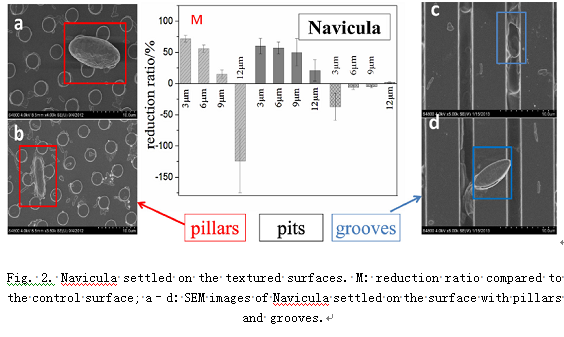Biofouling is of great concern in numerous applications ranging from biosensors to industrial and marine equipment. The self-polishing coatings are effective on reducing biofouling because of slow release of tin, copper or other toxins in time. But they had detrimental impact on nature.
Development of non-toxic and environment-friendly anti-fouling paints is the main trend of marine antifouling coatings. The ideal coating not only has antifouling properties but also can release foul.
Taking advantage of low surface energy and surface textures, Prof. Xuedong Wu’s group at the Ningbo Institute of Materials Technology Engineering (CNITECH) fabricated the siloxane modified acrylic resin (SMAR) coatings with various textures including pillars, pits and grooves. These micro-textured coatings showed different antifouling performances to Navicula Closterium and Ulothrix. The coating with pillars spaced 3 μm reduced Navicula settlement by 73% compared to the control surface. The largest reduction for Closterium, 81%, was obtained on the surface with grooves spaced 12 μm apart. The reduction ratio of the Ulothrix settlement on the surface with grooves spaced 12 μm apart could even reach 92%.
The results predict that a textured surface which having fit feature so that the algae can bridge on between two or more features, and do not provide the area for algae displaying excellent anti-fouling performance. Synergy of both structure and surface composition provides a promising way of designing environment-benign marine anti-fouling coatings.


This work was published in Applied Surface Science, 311 (2014) 703-708.
Key words: Biofouling; Texture; Wettability; Size; Algae
Prof. Xuedong Wu mailto:xdwu@nimte.ac.cn
Research Staff Url:http://english.nimte.cas.cn/pe/fas/200909/t20090929_44484.html
All Images by![]()

